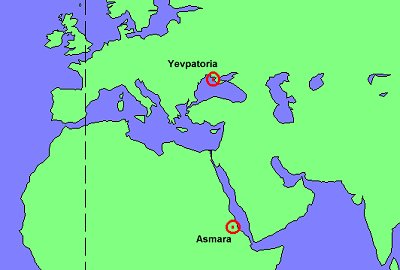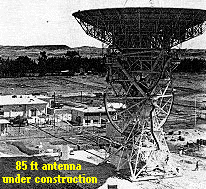I thought this was a very important observation so I have reproduced
this page in case it is removed from the web. Nothing has been changed. The
original location of this page was at:
http://www.svengrahn.pp.se/trackind/Deepspac/Deepspac.htm
Update
08/28/2006 - Sven has contacted me and informed me that the page is back online
at the above link.
Rick
The US Deep Space Intelligence Collection program
Sven Grahn
The United States have declassified a large number of highly interesting
articles about intelligence collection and analysis from the CIA publication
"Studies in Intelligence". Dwayne Day drew my attention to these articles and I
have been able to get access to copies of two of these articles (1) (2), both written by
James D. Burke and dealing with the system for collecting intelligence about
Soviet deep space missions by monitoring telemetry signals.
Jim Burke is a childhood hero of mine - he was the initial project
manager of the Ranger project. If you want to read about Jim, a truly great
space engineer, you should consult his "Personal Profile" (3). Recently I have had the privilege of meeting and
working with him at the International Space University in Barcelona and
Stockholm. Jim sent me a copy of (1) and I got
(2) by kind assistance from Dwayne Day.
Here is a short summary of the key points in these two articles:
In the early sixties the United States created a sophisticated system of
ground stations to monitor the flights in the Soviet lunar and planetary
exploration program. This was a joint effort between NSA, Norad, DIA's Defense
Special Missile and Astronautics Center, CIA's Office of Elint and Foreign
Missile and Space Analysis Center.
The first planetary launches that the U.S. monitored were the October
1960 Mars probes. The launch vehicle telemetry could be monitored and indicated
the heaviest R-7-based vehicle launched so far. The U.S. sensors also recorded
the launch of Venera 1, but did not track it into deep space. Neither did US
sensors track Mars-1 into deep space.
For Luna 4, launched in April 1963, the NSA had improvised a monitoring
system by using a 150 ft dish at the Naval Research Laboratory in Maryland. The
NRL station was able to monitor telemetry from the lunar fly-by, which occurred
88 hours after launch. Telemetry was described as "complicated and full of
variety".
During the flights of Zond 1 and 2 the US system still was not able to
track in deep space, but did track just after injection. That tracking data was
sent to the US for determination of the trajectory. Also, during the Zond 1 and
2 flights the US succeeded in picking up the uplink commands! The
location of the uplink monitoring station is in the original article, but
blacked out in the declassified copy of the article. However, it is mentioned
in (2) that the capability to monitor the uplink
was lost while Venera 9 and 10 were en route to Venus. The probes were launched
on 8 and 14 June 1975 and beginning in July 1975 all U.S. signals intercept
operations were suspended (4), due to a U.S. arms
embargo against Turkey because of its invasion of Cyprus. Thus, it seems
probable that the uplink monitoring station was in Turkey.
 A network of stations was set up, but the main station was placed
at Asmara - in then Ethiopia - (see map on the left) at almost the same
longitude as the main Soviet ground station in the Crimea. It had an 85 ft
antenna (operational in April 1965) and a 150 ft dish with lower surface
accuracy (operational in 1964). A search on the WWW reveals that there was a US
Army Security Agency station at Asmara, nicknamed "Kagnew Station", starting in
May 1950. Presumably the deep space monitoring station was co-located with the
army facility.
A network of stations was set up, but the main station was placed
at Asmara - in then Ethiopia - (see map on the left) at almost the same
longitude as the main Soviet ground station in the Crimea. It had an 85 ft
antenna (operational in April 1965) and a 150 ft dish with lower surface
accuracy (operational in 1964). A search on the WWW reveals that there was a US
Army Security Agency station at Asmara, nicknamed "Kagnew Station", starting in
May 1950. Presumably the deep space monitoring station was co-located with the
army facility.
The first spacecraft that the Asmara station (read the
U.S. Department of Defense news release about its
creation) tracked was Luna 5 launched in the direction of the moon in May 1965.
Asmara picked up "both of the two spacecraft signals", measured Doppler shift
and could not find any evidence of retrorocket firing. Asmara also tracked Luna
6, but missed Zond 3 because it did not obtain a "fix" during injection, with
which to determine the trajectory further away from the earth. Asmara tracked
Luna 7 and confirmed that no retrofire occurred.
 The Venus 2 and 3 flights were not tracked into deep
space by Asmara, and the other stations missed the injection of Venus 2 because
it used 51.6 deg inclination for the parking orbit instead of 65 degrees.
The Venus 2 and 3 flights were not tracked into deep
space by Asmara, and the other stations missed the injection of Venus 2 because
it used 51.6 deg inclination for the parking orbit instead of 65 degrees.
Luna 8 was observed by Asmara to decelerate during descent, but not
enough for a soft landing. During the flight of Luna 9, Asmara, Jodrell Bank,
Naval Research Laboratory and The Royal Radar Establishment were all listening.
The US sensors also picked up the pictures and produced printouts of them, just
like those of Jodrell Bank, but stamped SECRET!
The Asmara station, code-named STONEHOUSE, operated from 1965 to 1975.
It had to be shut down because of political unrest in Ethiopia. At the time
(during the flight of Venera 9 and 10) the uplink monitoring station was lost
also. The Asmara site had picked up telemetry on 183.6, 922-928 MHz and 3.7 GHz
(4x the 900 MHz signal) from Soviet deep space probes, but failed initially to
detect the telemetry on "5 cm". The story in (2)
ends here, but it seems that finally this frequency must have been detected. We
now know that the "5 cm-band" meant 5870-5890 MHz.
References
- James D. Burke, "Seven Years to Luna 9",:
Studies in Intelligence, Summer 1966
- James D. Burke, "The Missing Link",
Studies in Intelligence, Winter 1978
- Spaceflight, April 1984, pp. 178-183
- James Bamford, "The Puzzle Palace",
Houghton Mifflin, Boston 1982, p.160.

 A network of stations was set up, but the main station was placed
at Asmara - in then Ethiopia - (see map on the left) at almost the same
longitude as the main Soviet ground station in the Crimea. It had an 85 ft
antenna (operational in April 1965) and a 150 ft dish with lower surface
accuracy (operational in 1964). A search on the WWW reveals that there was a US
Army Security Agency station at Asmara, nicknamed "Kagnew Station", starting in
May 1950. Presumably the deep space monitoring station was co-located with the
army facility.
A network of stations was set up, but the main station was placed
at Asmara - in then Ethiopia - (see map on the left) at almost the same
longitude as the main Soviet ground station in the Crimea. It had an 85 ft
antenna (operational in April 1965) and a 150 ft dish with lower surface
accuracy (operational in 1964). A search on the WWW reveals that there was a US
Army Security Agency station at Asmara, nicknamed "Kagnew Station", starting in
May 1950. Presumably the deep space monitoring station was co-located with the
army facility.  The Venus 2 and 3 flights were not tracked into deep
space by Asmara, and the other stations missed the injection of Venus 2 because
it used 51.6 deg inclination for the parking orbit instead of 65 degrees.
The Venus 2 and 3 flights were not tracked into deep
space by Asmara, and the other stations missed the injection of Venus 2 because
it used 51.6 deg inclination for the parking orbit instead of 65 degrees.